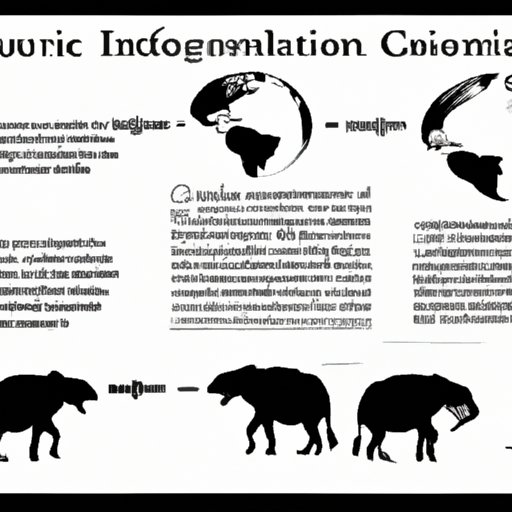Introduction
Culture is an ever-evolving concept that has been shaped by numerous external forces throughout history. But what exactly does it mean for culture to change? How does this transformation happen and what factors contribute to it? This article will explore the various ways in which culture can change, including through the influence of technology, immigration, globalization, geography, education and media.

Examining the Role of Technology in Shaping Culture
Technology has had a profound impact on human culture, from the invention of the wheel to the development of the internet. In today’s digital age, technology is increasingly playing a role in shaping our cultural practices, beliefs, and values. Technological advancements have enabled us to communicate and interact with people around the world, which has had a major influence on our cultural attitudes and behaviors.
Impact of Technology on Cultural Practices
The introduction of new technologies has changed the way we interact with one another and our environment. For example, the widespread adoption of the internet has enabled people to access information more quickly and easily, leading to a shift in the way knowledge is shared and consumed. Additionally, social media platforms such as Facebook and Twitter have allowed people to connect with others all over the world, creating a global network of communication.
Examples of Technology Influencing Culture
One of the most notable examples of technology impacting culture is the introduction of the smartphone. Smartphones have become ubiquitous in modern society, allowing people to stay connected no matter where they are. This has had a significant effect on our social interactions, with people becoming more reliant on their devices for communication and entertainment. Additionally, the rise of e-commerce has changed the way we shop, with online stores providing more convenient and accessible shopping experiences than traditional brick-and-mortar stores.
Exploring the Impact of Immigration on Cultural Change
Immigration has long been an important factor in shaping culture, bringing together people from different backgrounds and cultures. The influx of new ideas and values can have a major impact on a society’s existing culture, resulting in changes in language, customs, and beliefs.
How Immigration Affects Cultural Values
Immigration can lead to a blending of cultures, as immigrants bring their own values and beliefs to a new society. This can result in a fusion of cultures, with elements from both sides being adopted and adapted. Additionally, immigration can lead to an increase in diversity, as different groups of people bring unique perspectives and experiences to a community. This can lead to greater acceptance of different cultures and identities.
Examples of Immigration Affecting Culture
Immigration has had a major impact on the culture of the United States, with millions of immigrants coming to the country over the past centuries. This influx of people from different countries and cultures has led to a blending of traditions and beliefs, resulting in a unique American identity. Additionally, the presence of immigrants has had a positive effect on the economy, with many immigrants starting businesses or contributing to the workforce.

Analyzing the Influence of Globalization on Cultural Evolution
Globalization is another factor that has played a major role in shaping culture. The increased interconnectedness of the world has made it easier for ideas and products to spread across borders. This has had a significant impact on cultural beliefs and practices, with people being exposed to different perspectives and ideas.
The Benefits of Globalization on Culture
Globalization has had a positive effect on culture, as it has enabled people to learn about different cultures and gain access to new products and services. Additionally, globalization has led to increased economic opportunities, as countries are able to access resources and markets from other parts of the world. Finally, globalization has also helped to foster peace and understanding between nations, as people from different countries are able to interact and learn from one another.
Examples of Globalization Impacting Culture
Globalization has had a major impact on the culture of the United States, with the introduction of new foods, music, and customs. Additionally, globalization has led to an increase in diversity, as people from all over the world have moved to the country in search of better opportunities. Finally, globalization has also impacted the American economy, as companies have taken advantage of lower labor costs abroad while still accessing the US market.
Investigating How Geography Affects Cultural Transformation
Geography can also have a major impact on culture, as different regions have their own unique set of characteristics and influences. These can include climate, terrain, and access to resources, all of which can shape a region’s culture.
Geographic Factors Impacting Culture
A region’s climate and terrain can play an important role in determining its culture. For example, a region with a warmer climate may be more conducive to outdoor activities, while a region with a colder climate may be more focused on indoor activities. Additionally, a region’s access to resources can affect its culture, as access to certain resources may lead to a focus on certain activities or lifestyles.
Examples of Geography Influencing Culture
Geography has had a major impact on the culture of the United States. For example, the warm climate of the southern states has led to a focus on outdoor recreational activities, while the colder climates of the northern states has encouraged the development of indoor activities such as skiing and snowboarding. Additionally, the abundance of natural resources in the western states has led to a focus on mining and agriculture.

Assessing the Influence of Education on Cultural Development
Education is another factor that can have a major impact on culture, as it can shape a society’s values and beliefs. Education can provide people with knowledge and skills, which can lead to a greater understanding of different cultures and beliefs.
Impact of Education on Cultural Beliefs
Education can help to promote tolerance and understanding between different cultures, as people are exposed to different beliefs and values. Additionally, education can lead to a greater appreciation of cultural diversity, as people are able to learn about and respect different cultures. Finally, education can also lead to a greater understanding of global issues, as people are exposed to different perspectives and ideas.
Examples of Education Influencing Culture
Education has had a major impact on the culture of the United States, as schools have provided students with an understanding of different cultures and beliefs. Additionally, education has helped to promote tolerance and acceptance of different cultures, as students have been taught to respect and appreciate diversity. Finally, education has also helped to increase awareness of global issues, as students have been exposed to different perspectives and ideas.
Evaluating the Influence of Media on Cultural Transformation
Media is another factor that can have an impact on culture, as it can shape public opinion and influence people’s beliefs and values. Media outlets such as television, radio, and newspapers can provide people with information and entertainment, which can have a major impact on their views and behaviors.
How Media Impacts Cultural Norms
Media can have a major impact on a society’s cultural norms, as it can shape public opinion and influence people’s beliefs and values. For example, television shows and movies can provide people with an insight into different cultures and lifestyles, which can lead to a greater understanding and acceptance of different cultures. Additionally, news outlets can provide people with information about current events, which can lead to a shift in public opinion.
Examples of Media Influencing Culture
Media has had a major impact on the culture of the United States, as television shows and movies have provided people with an insight into different cultures and lifestyles. Additionally, news outlets have provided people with information about current events, which has led to a shift in public opinion. Finally, social media platforms such as Facebook and Twitter have enabled people to connect with others all over the world, creating a global network of communication.
Conclusion
Culture is an ever-evolving concept that has been shaped by numerous external forces throughout history. This article has explored the various ways in which culture can change, including through the influence of technology, immigration, globalization, geography, education and media. Each of these influences can have a major impact on a society’s existing culture, resulting in changes in language, customs, and beliefs. Ultimately, it is clear that culture is constantly changing and adapting to new influences, making it an ever-evolving concept.
Summary of Findings
This article has explored the various ways in which culture can change, including through the influence of technology, immigration, globalization, geography, education and media. It has examined how each of these influences can shape cultural values, norms and beliefs, and has discussed some examples of how they have impacted the culture of the United States. Overall, it is clear that culture is constantly changing and adapting to new influences, making it an ever-evolving concept.
Implications for Future Research
There is still much to be learned about the various ways in which culture can change, and further research is needed to understand the full extent of the impact of these influences. Additionally, further research could examine how different cultures have been impacted by these influences, and how this has resulted in changes in language, customs, and beliefs. Finally, further research could investigate how future technological, economic, and political developments could shape culture in the years to come.
(Note: Is this article not meeting your expectations? Do you have knowledge or insights to share? Unlock new opportunities and expand your reach by joining our authors team. Click Registration to join us and share your expertise with our readers.)
